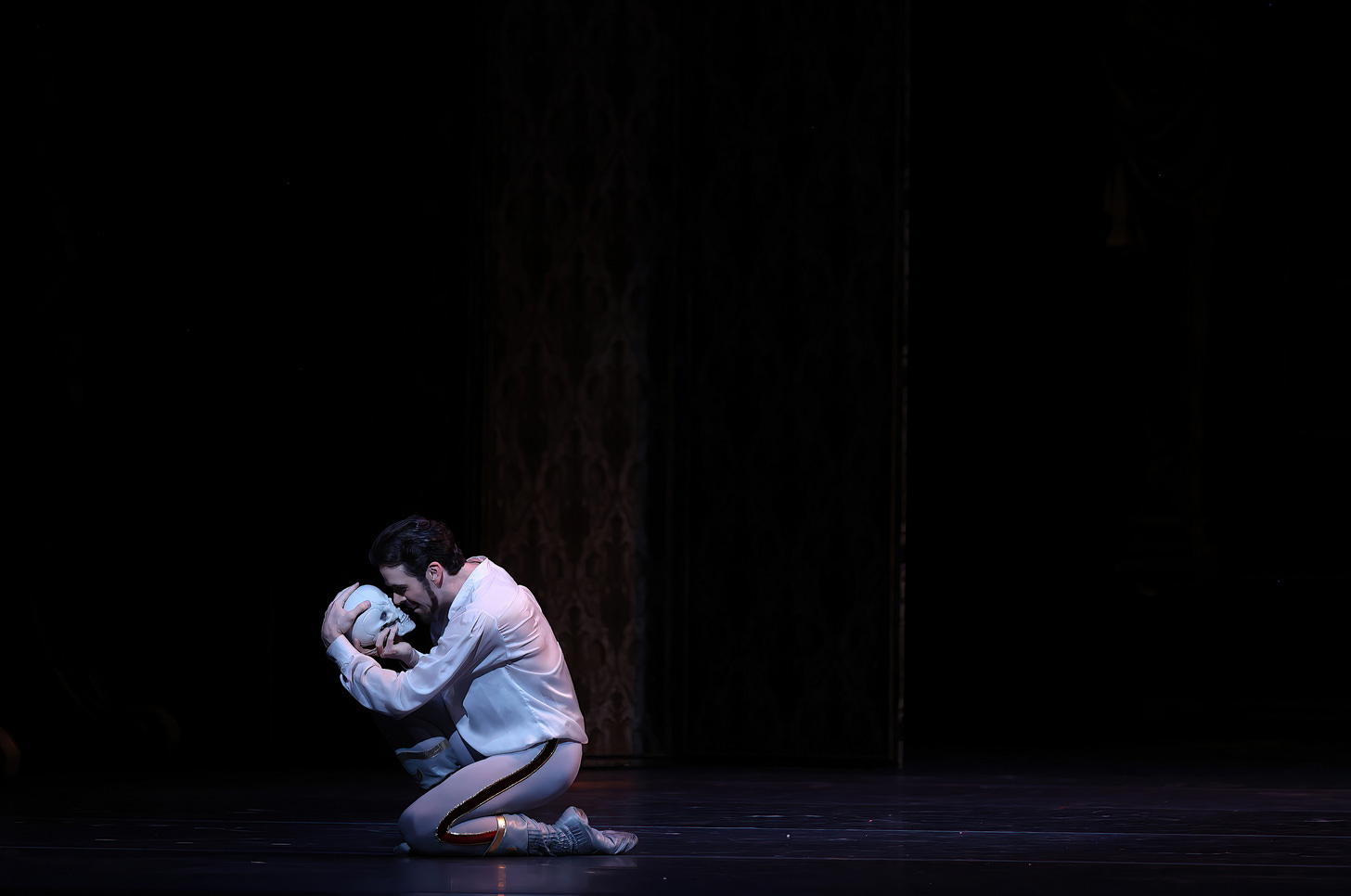
Film is a copy of fakery. The live stage is fakery, too, but it’s the real thing.
Film, unlike the live stage, is static. Once a take is chosen, no one will ever play the role again; to watch it twice is to repeat an unvarying performance. Film is a two-dimensional copy of a 3-D performance; but not of the whole person actor. Rather its focus on delimited torsos and disembodied heads amputates meaningfulness here, hyperbolizes there. Film actors play, not to human beings in an audience which changes with each show and whose immediate responsiveness drives the actor’s own responsive stage performance; but to a machine.
At its heart, film is a flattening, deadening gimmickry that reduces the aesthetic grandeur and communicative affectiveness of even great performances. Wasn’t it Edith Evans who, when asked in the 1960s what she thought of television -- then an even smaller two-dimensional screen than the predominant large-screen TV on which film mostly plays today-- replied, “Oh, I feel sorry for the actors who have to play to that little box. On the stage, one can be BIG.”
[UPDATED, July 24, 2024: No, it wasn’t Edith Evans, but Sybil Thorndike:
At approximately 1:49 of this interview, Dame Sybil discusses the miniscule nature of the TV screen in contrast to Life on Stage.]
Films can and do delight, amaze and inspire. Dinner at Eight (1933), my favorite, gives rise to a tear-to-the-eye wistful gladness to see its stage actors, whose outstanding theatrical skill would have otherwise disappeared from sight forever. Bondarchuk’s War and Peace (1965) inspires a jaw-dropping awe at its invented battlefields of thousands of costumed soldier-extras engaged in mock war amidst explosions and smoking ruins. Thank goodness for the filming of Richard II (1978) so that one may delight in and study the masterful delivery of Shakespearean language by superbly trained, literate stage artisans. (There were few Americans then and none now who can deliver it.)
Yet, even so, even when projected against an enormous screen, film is a reduction of our bountiful humanity: A diminution of meaningfulness because the wholeness of Life must be truncated to fit within its flat earth. Only the live stage can make human beings and, more importantly, the ideas that enliven the action -- the raison d’ètre of theater -- appear to be larger than life and, thus, fully humane and infinitely more persuasive.
Live stage performance is dynamic: Each performance plays differently, even with the same company. The theater audience sees the whole person with real depth of movement and hears genuine, not copies of, human voices resonate the hall. Nothing is winnowed by an invasive mechanical intermediary.
All acting is fakery and make-believe. But, on the live stage, it appears to come to life; and in a successful production, in a way that film can never reach. I have never experienced, when watching any film, the catharsis of which I as a teenager had read in the theatrical writings of the ancient Greeks, as I did for the first time in my life 40 years later. It is almost a certainty that few Americans alive today have ever felt it: So few Americans have ever been to the theater and, when they have, little is put on of any theatrical or aesthetic worth.
Catharsis is a sudden, overwhelming, oceanic feeling in the flesh that effects an alteration in consciousness. My virgin catharsis, so to speak, occurred during the climactic final scene of Wozzeck which played at the Metropolitan Opera in 2011. As Alan Held’s Wozzeck, set against a 50 foot-high setting sun plastered on the cyclorama at the back of the stage, submerged into the stage floor and out of sight, I felt my body shudder and my mind reel. I recall standing, as if I to pull the character up out of his own demise with my hands. “Goodness gracious!” I thought as I looked about at the audience that had risen with me, but rather to applaud, “What had just occurred?”
I had been convinced that all the fakery had been real. My body demonstrated the alteration effected in consciousness, for I had been washed and renewed, thoroughly cleansed in an aesthetically emotional sense, just as Greek theater practitioners had intended their work to carry out its effects upon ancient audiences 2,500 years ago.
I experienced it again, twice, at the Houston Ballet’s Mayerling, which closed on June 2, 2024.
Houston Ballet’s Mayerling Demonstrates the Superiority of the Live Stage
(A ballet in three acts with a cast of approx. 30 dancers)
I am a neophyte of the dance, without any knowledge of its history and methods. Physical movement as an expressive art is foreign to me; like the building of a skyscraper. About five years ago, for some reason, after a lifetime of ignoring classical dance, the beauty of balletic movement suddenly appealed to me. Perhaps it had been the minor physical infirmity I then temporarily encountered or advancing age that had stimulated this newly awakened receptivity.
I came to marvel at the capacity of the dancer to enact meaning without words – the stuff and substance of my expressive life, as a writer and performer myself – beautifully, elegantly, touchingly, fetchingly, without any seeming effort. (Though one recalls Eddie Villella
saying how, as a youth, they’d rehearsed on concrete floors! The bloody feet, the constant pain, the damage to the joints, etc. How do dancers do it?)
Dance, for me, seems to be a kind of a sacrifice of the body for its overcoming, so as to deny its physical power over the immortal soul which uses it for a higher – divine and aesthetic – ideal than the mundane, animal self-servicing all human beings must suffer. That is dance’s attraction for me. When I experience its rare achievement, I’m amazed: but twice in one week by the same company must be miraculous. No: In fact, that “miracle” is the fulfillment of the theatrical promise of the live stage.
The Ballet
Mayerling is the name of the Austrian village in which, in 1889, Prince Rudolf shot and killed Baroness Mary Vetsera, and then himself. The ballet of that name, choreographed by Sir Kenneth MacMillan to the music of Franz Liszt, selected and arranged by John Lanchberry, takes the event as its inspiration. I encourage you to read the well-written story synopsis here.
Every live performance is a rebirth and every performer worth his salt gives a new performance at every performance. Performer A will play the character in his own way, as will Performer B. Food provides an ample, simple, if humorous, analogy. At the cheesemonger, one might get cheddar or swiss, but both are cheese. Taste varies because each has its own recipe; a master fromager makes quality in his own way, but quality is quality.
I attended two performances. In the first, I sat in the orchestra about 10 rows back, level with the stage. Skylar Campbell and Melody Mennite danced the lead roles. A week later, I sat in the Grand Tier about 100 feet behind those seats and at a 45 degree angle above. Conor Walsh and Karina Gonzalez danced the lead roles in that performance.
The story, the choreography and the music had not been altered; the same characters portrayed by these different dancers were so like the analogous cheddar and swiss as to achieve vastly separate meanings, though each resounded within me as entirely truthful and persuasive. Remember, please, as you read my impressions, from which my conclusions follow, that my eye is untrained in dance and I do not know even the terminology of steps.
THE FIRST PERFORMANCE
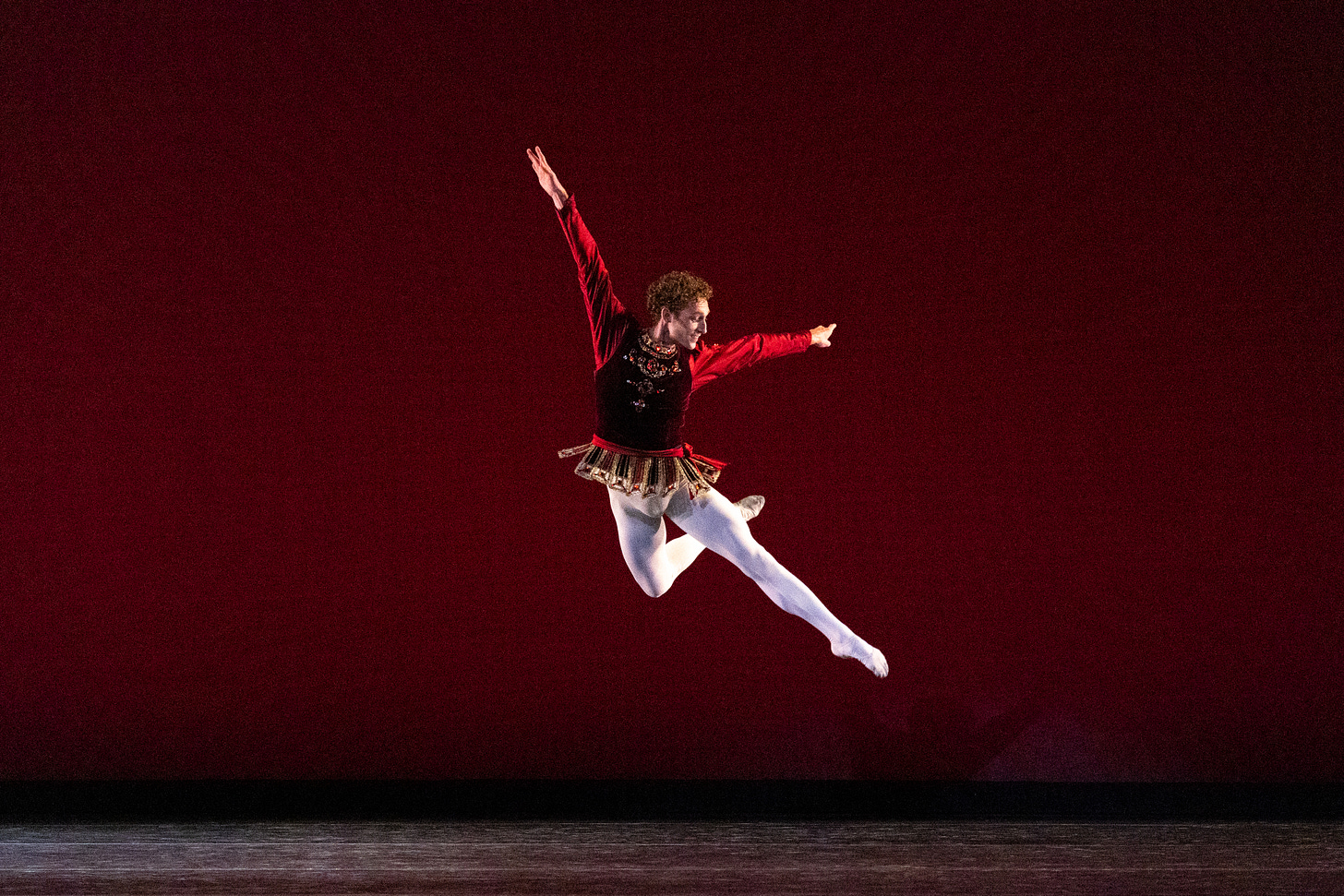
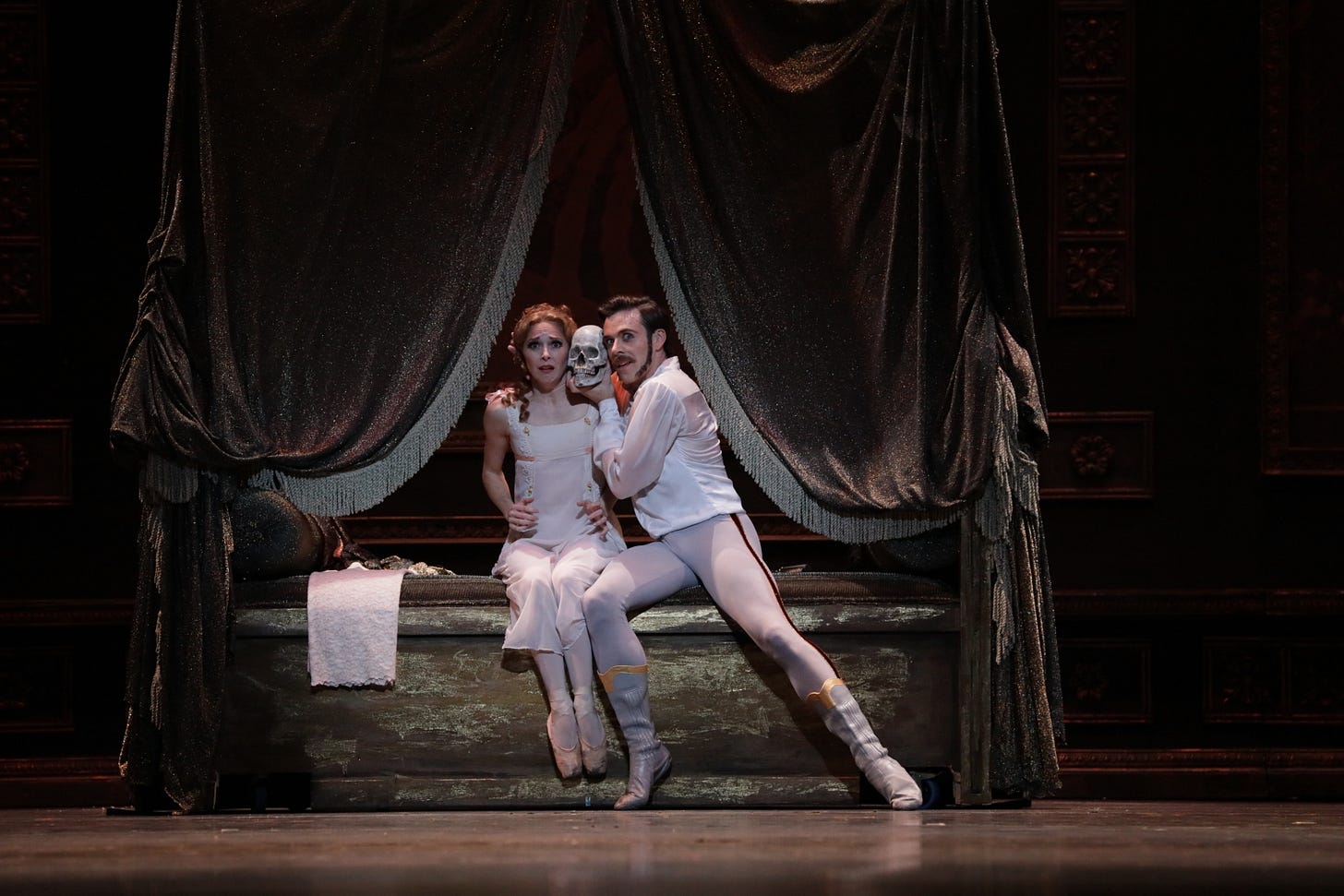
Sklyar Campbell danced Rudolf with a passionate, athletic intensity, brutish, emotional, mercurial, unpredictable, moody, abysmally self-mortifying at times, skyscrapingly overjoyed at others. A rebel from the first step, with no real fear of his Emperor-Father, bucking at the merest restraint, probing the limitations of courtly courtesy and even good judgment, martial of temperament and inviting conflict with bravado.
His Rudolf and Melody Mennite’s Mary (Baroness Vetsera) were perfectly matched, like the Yin and the Yang, fitted into an exact pair of opposing aggressive masculine and recessive feminine qualities. I have never seen eroticism danced in this way, as Skylar Campbell manhandled the rag-doll Mary in obsessively clutching arms, at times literally throwing her, allowing Melody Mennite to make use of her marvelously graceful arms that seemed flail helplessly, unattached to her torso. [I have seen film of Makharova’s arms. It’s like what LeBron James does on the basketball court. How?]
How aggressive? This Rudolf violently rapes Princess Stephanie (Aoi Fujiwara), his blameless fiancée who only hopes to please him whom she fails to understand, with a ruthlessly commandeering brutality that I found so shocking that I discovered with surprise that I had been angered. What a coup for any performer to engender a visceral response in a member of the audience!
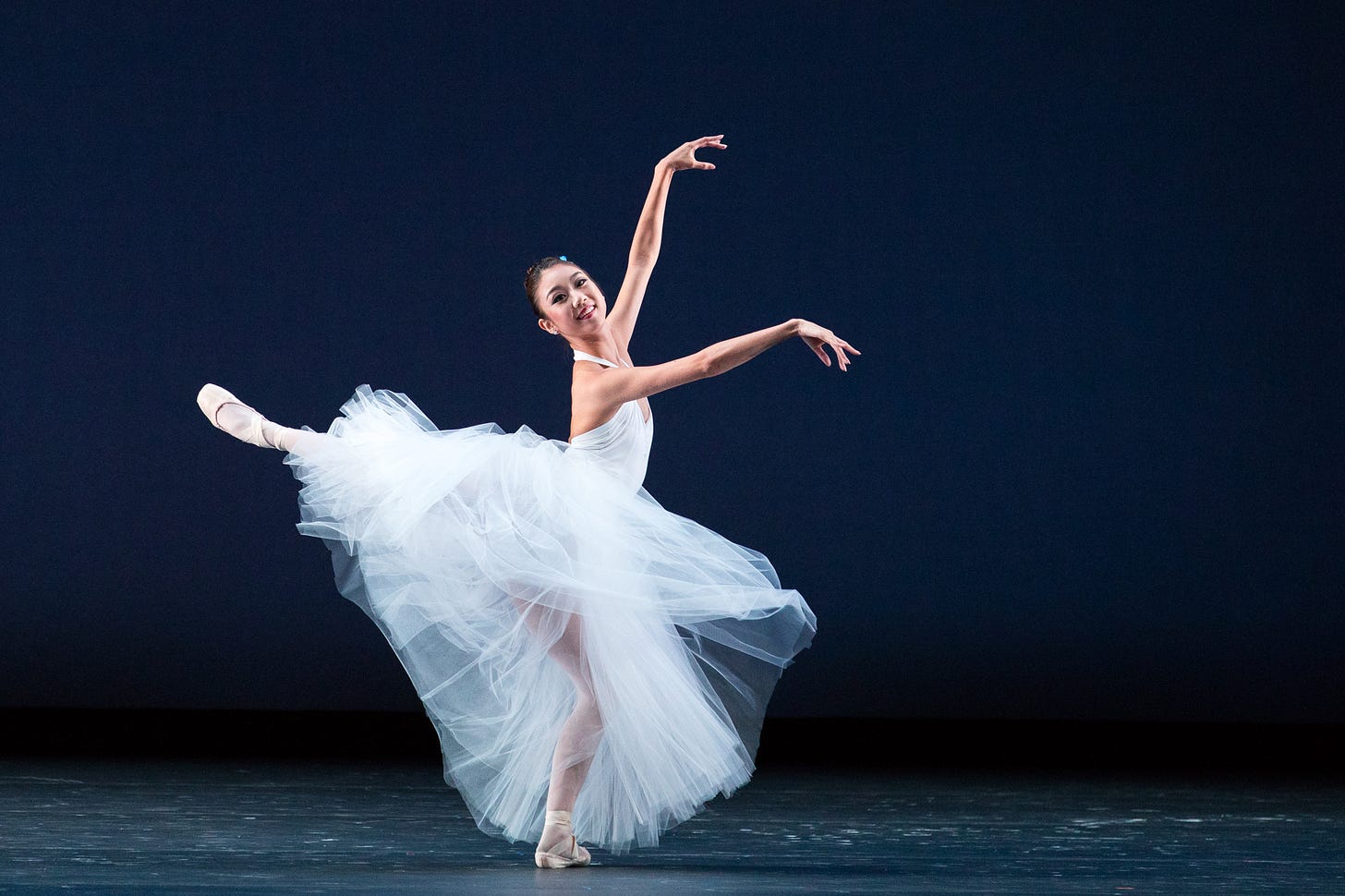
Perhaps, I thought, as I watched, MacMillan had conceived of Rudolf as a James Dean anti-hero, a kind of character just coming into dramatic development a century ago and which now dominates youthful male dramatic characterization. For that is how I saw this conception of him: a bad boy whose attractiveness might make seem endearing, and whom a certain kind of young woman gravitates to. [The upholding of an anti-hero as model is so unfortunately widespread now that it received its famous parody in the Seinfeld episode in which George suddenly attracts a beauty by pretending he’s baaaaad.
My conclusion: It was not Rudolf’s tragedy, but rather Mary’s. Enamored, an innocent magnetically attracted to, dazed and overwhelmed by his rough masculinity, she eagerly suffers her own execution by his hand, passionately sacrificing to love. One could only pine for her, her inexperience, her compulsion, and, thus, her erroneous and fatal judgment. Rudolf, on the other hand, was not an innocent, but a rogue and a cad; yet, though not a tragedy in a classical sense, one could still have a profound sympathy for his own species of suffering. He had not chosen to be born a scion of a despot, compelled unwillingly to suffer an arranged marriage, to live a luxurious imprisonment from which irremediable circumstance no boy so passionately and willfully engaged in living could escape, other than in death.
THE SECOND PERFORMANCE

The following week I watched Conor Walsh as Rudolf and Karina Gonzalez as Mary. Whatever I had learned about the two characters the week before, I had to leave at the proverbial stage door. Conor Walsh’s Rudolf was, to fulfill the analogy, the Paul Newman to Skylar Campbell’s James Dean. Conor Walsh’s Rudolf was an elegant and thoughtful would-be diplomat with a martial rectitude – at least, at first. Distinctively different from Skylar Campbell’s Rudolf with his first step, Conor Walsh’s appearance at court was less physically boisterous and intense, even muted. Rather than demonstrating outright rebellion, this Rudolf more inwardly chafed at his father’s intimidating nature. In turn, the Emperor seemed to now be a malevolent bully. How this turn of events surprised me!
Intrigued, at the end of Act 1, knowing how the ballet must conclude, I predicted that I would see this dancer engage in a three act development -- an arc of character. In fact, the fuse of character he deftly lighted in the first scene of Act 1 progressed through ever more incendiary flame until Act 3’s final explosive gunshots. Conor Walsh’s movement, always elegant, moved gradually from subtle to rather less than subtle and then finally to real reaching: The burdens placed upon the character’s consciousness shown in their gradual development to a species of exaggeration through the body.
This Rudolf was not merely an impolite, pampered darling whose behavior at court in the first Act might have been explained as nervous anticipation. For in the stunningly costumed and humorously danced scene in the brothel, Rudolf proved himself to be a kind of wastrel nobility. But at his core? While I was certain that the Skylar Campbell Rudolf’s core nature was that of a wastrel, it occurred to me that Conor Walsh’s Rudolf was situationally, and not intrinsically, a wastrel: His naughty behavior perhaps the product of an expectation of his peers. Perhaps he was not really a rogue?
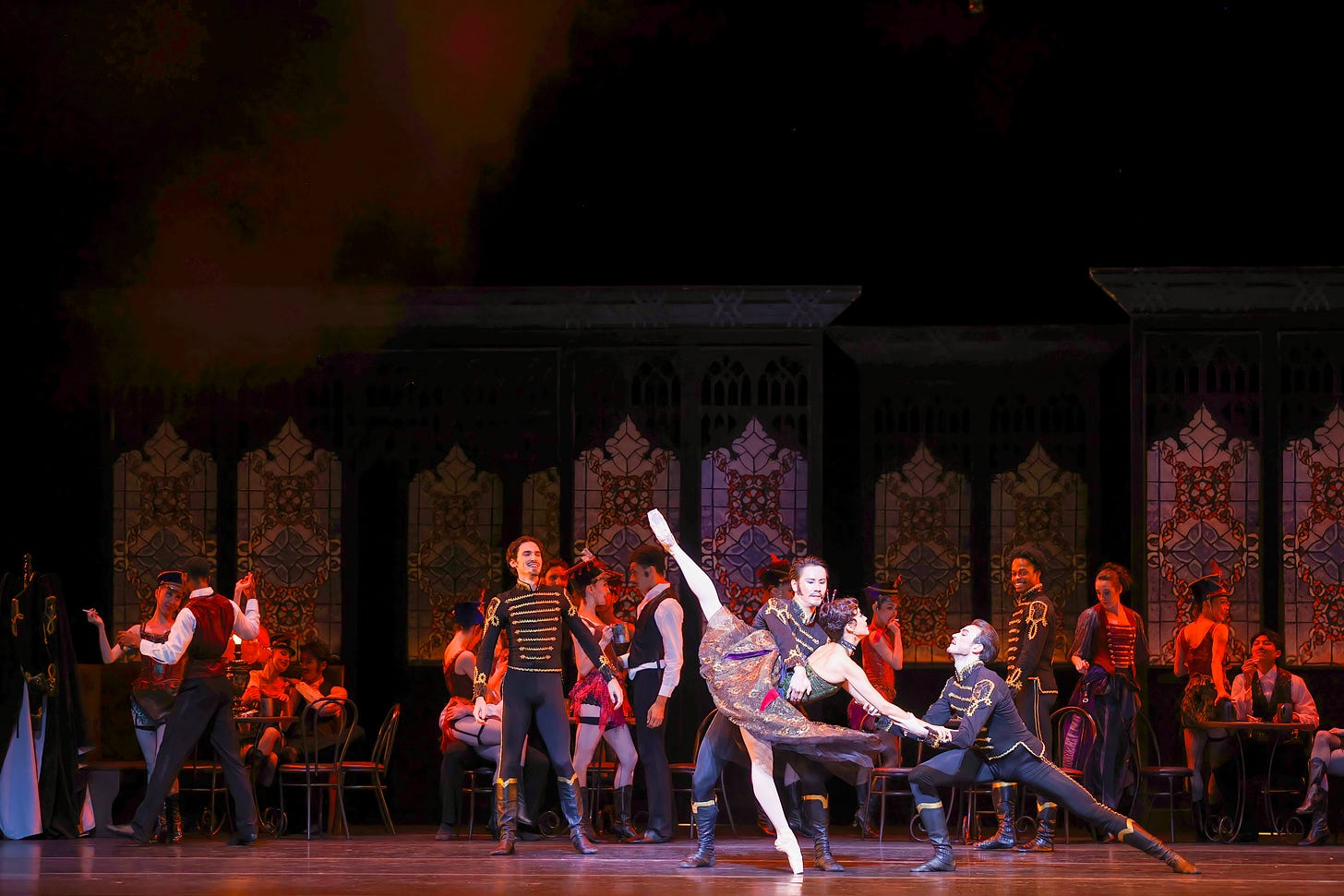
Conor Walsh’s Rudolf was exquisitely tender, even doting to his Mary, who was in turn more a thoughtful companion his equal in temperament. The two were just as fitting a Yin and Yang dyad as I had seen the week prior – but of utterly different qualities. This Rudolf was just as tortured by his golden imprisonment as the other, but here, the tragedy seemed to be Rudolf’s; for this Mary was not led to the abyss unknowingly. This Mary was dutiful. It might seem to be plausible at this stage of the ballet to consider self-extinction a natural and fitting conclusion to the impossibility of their love.
But the violence of this rape scene in Act 3 closed my mind to any thought that this Rudolf was just a slightly soiled angel; for Monica Gomez’s Stephanie, which differed dramatically from Aoi Fujiwara’s, put up a tremendous fight. This Rudolf was, in fact, an outwardly cultured imperial brute with an obsessive drive to sexually punish a blameless equal despite the “NO” she levied in vain against him with her fists.
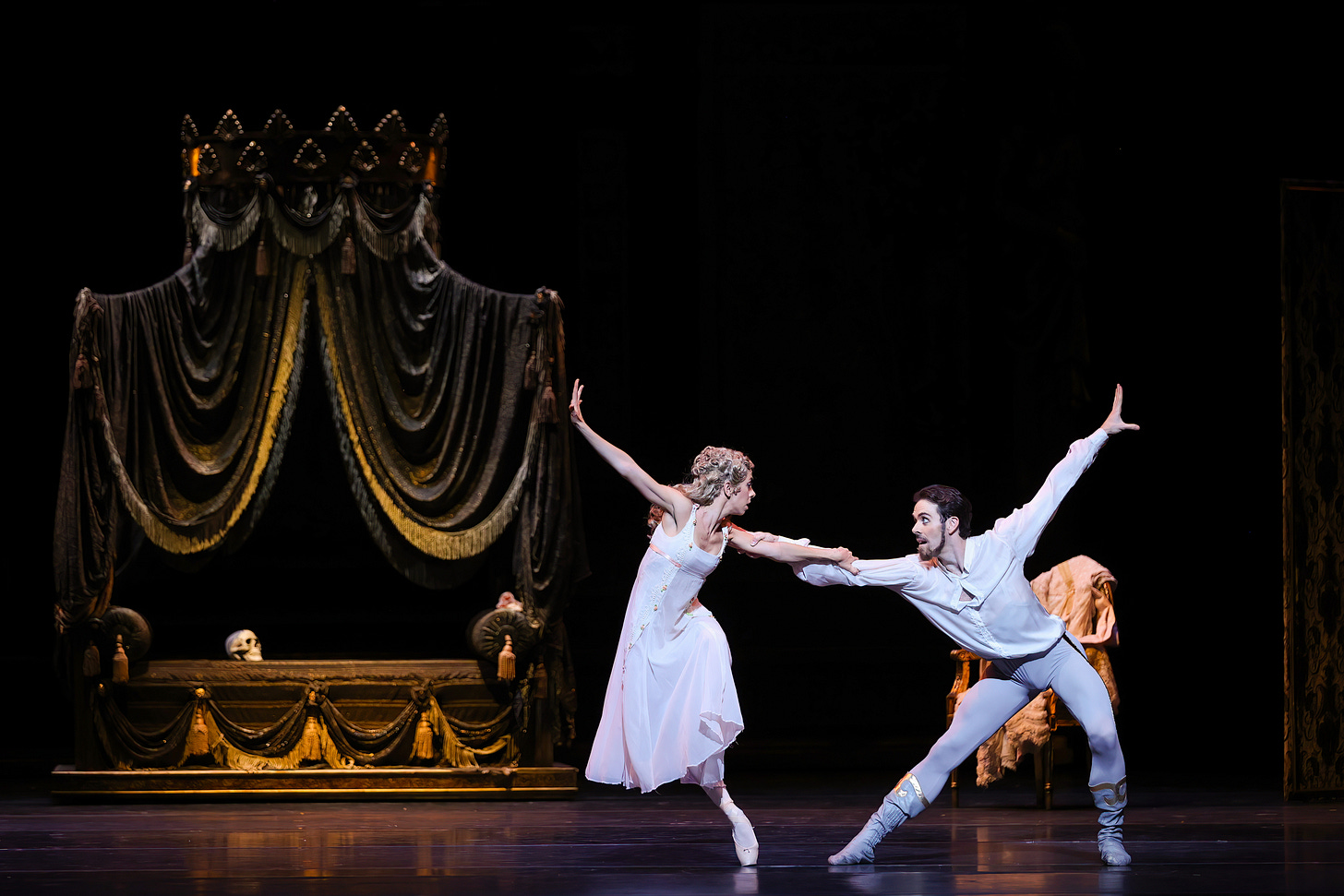
THE FINAL EXPLOSIVE ACT
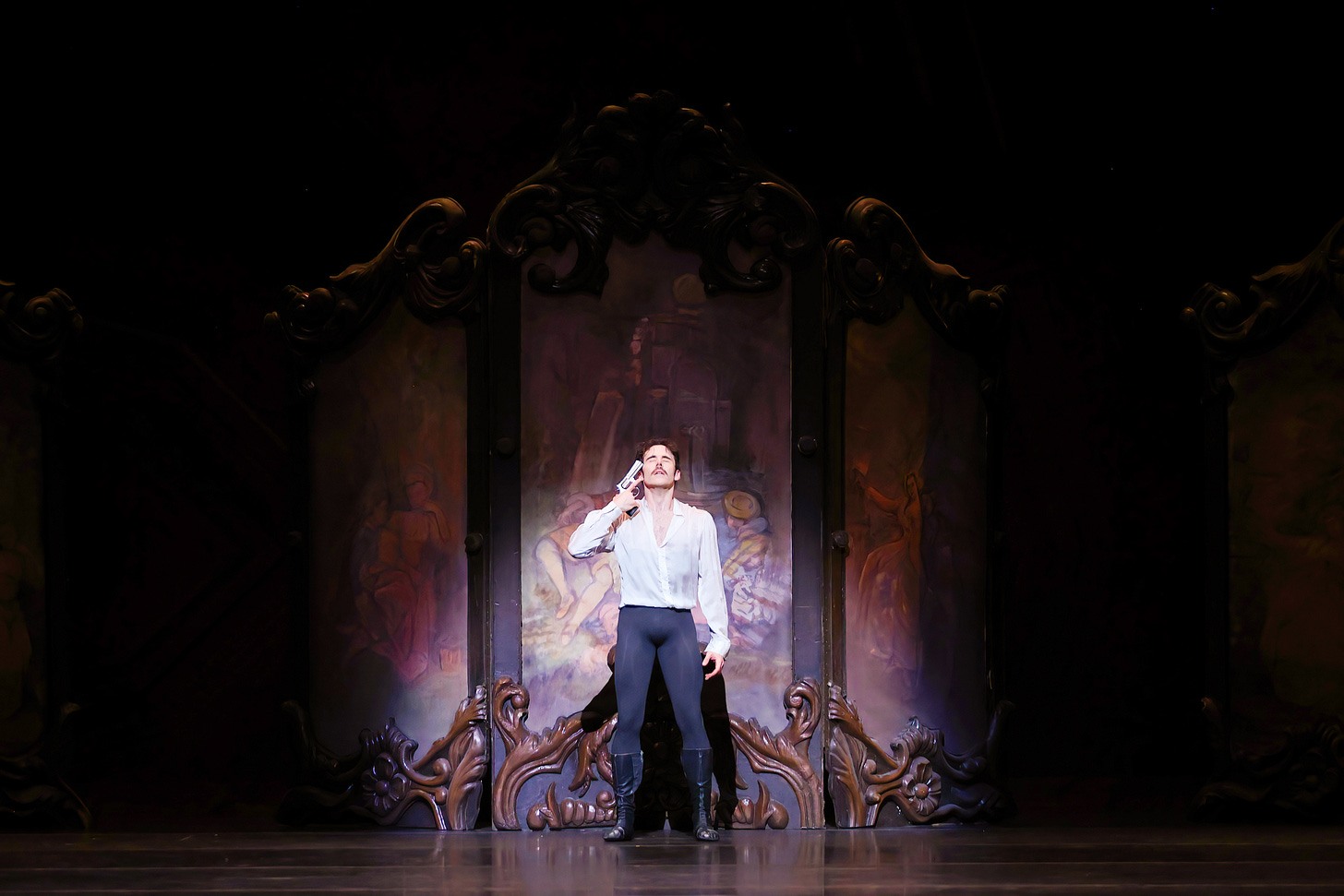
The ultimate dramatic scene of Rudolf’s suicide takes place behind the screen you see in the image just above. The impact of the self-inflicted killshot sends his body upstage, bringing down onto center stage the screen which clatters with a bang, the corpse atop it. Skylar Campbell’s Rudolf flung his body up against the screen with a violence that must have bruised the dancer (!) when he hit the floor; there was a slight delay of perhaps two seconds in the consummation of Conor Walsh’s enactment. That screen came down without the bust-out violence, but rather gracefully soaring down. Expecting a boisterous noisy end, I wondered if that infinitesimal delay had been planned – regardless, its elegance in death was totally in keeping with the character this Rudolf had been in life.
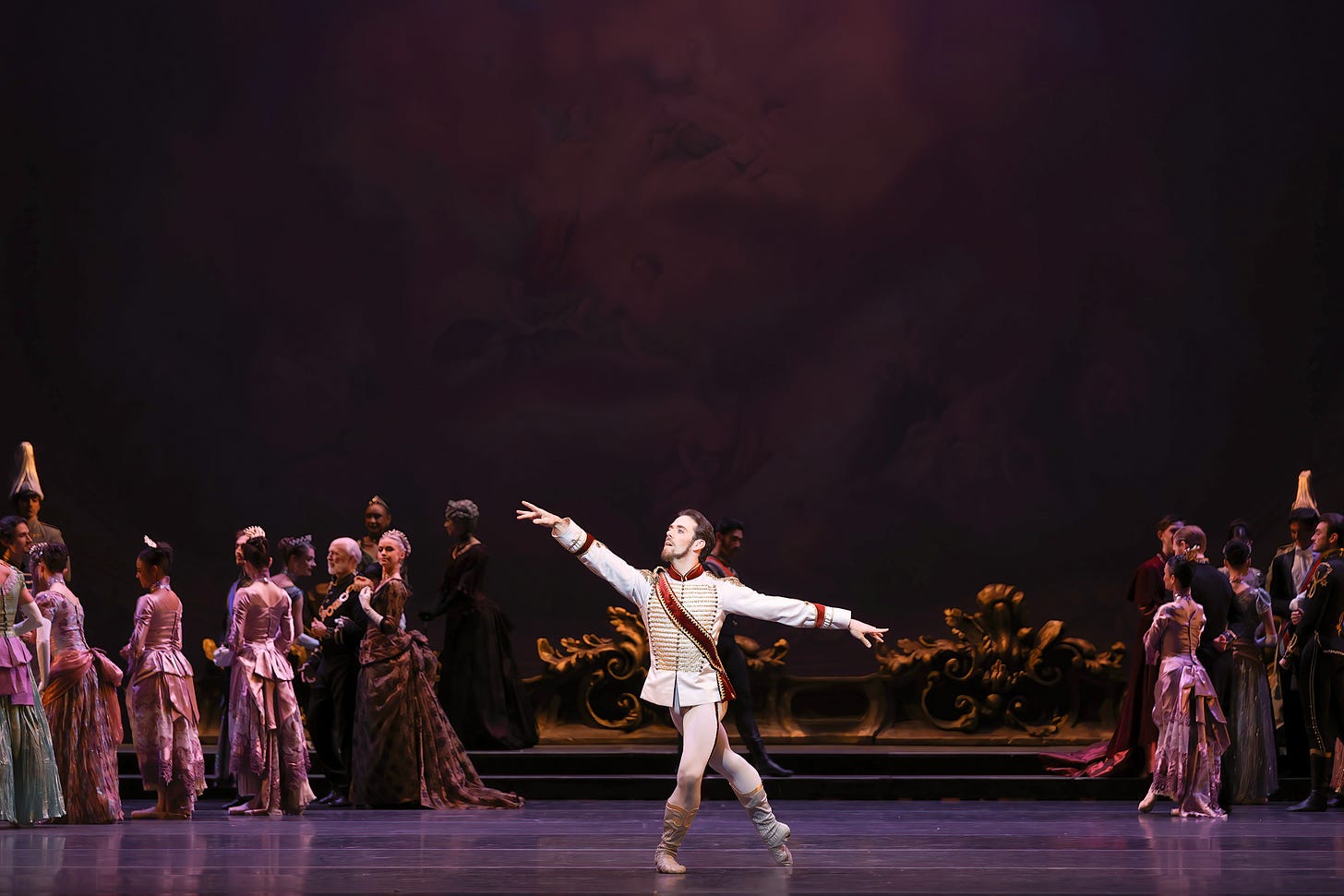
NOT TWO TRUTHS: ONE TRUTH, DIFFERENTLY DISPLAYED
Were both these disparate depictions Rudolf? Yes! Nothing was less than truthful about this stage fakery in either performance. I was persuaded throughout that each character had been honestly portrayed – certainly not contrived, but rather retrieved from the soul of the artist playing the character; that every movement was intentionally meant, and thus meaningful; and that choreographical intention as well as the spirit of the music had been lovingly respected.
Some might be moved to claim that either or any presentation of a dramatic work to be “valid.” This is wrong. There is a right way, perhaps many right ways; there are even more wrong ways. But “validity” requires one to go further than to claim it’s all okay any way: To disdain the existence of truth. Persuasive stage fakery is more than simply valid: It is true. There is one truth, differently displayed.
BRIEF MENTIONS BEFORE CONCLUDING
There were other, seemingly endless discoveries in the performances of other dancers and I feel remiss in not treating of them individually, but this essay must confine itself to my conclusions: 1) live stage performance is infinitely more effective in the communication of aesthetic meaningfulness than film, and 2) HBT consistently succeeds aesthetically, theatrically and meaningfully.
But I can’t end this essay without a mention of the stage lighting (Lisa J. Pinkham): It suffused an old-world beauty, heightened clarity of indoor candle-lighting before electric lamps, brightened the stage as would the sun through a panoply of glass French doors in a ballroom; darkened the stage to almost indistinction of a moon-less night in a cemetery where the Prince was buried, near his lover, in unconsecrated ground. Even the stage manager (Jonathan Moore) must be praised – what complexity he managed, all without a hitch to the audience.
I wish I had seen the third cast as well! My wife and I are season ticket holders. Now I’m thinking I’m likely to attend more than one performance of a production.
Many thanks to Elizabeth Sosa Bailey, the ballet’s public relations manager, for her willingness to provide the images that fill out this essay. [While photos of the cast of the first performance with Skylar Campbell and Melody Mennite were unavailable, Elizabeth kindly provided additional shots of the cast from other performances.]
A note to HBT:
I attended the first show with my brother, James Kuslan, writer, librettist and lecturer on opera (Listen to James’s appearance on WQXR’s “He Sang/She Sang” discuss Werther: Massenet's Lovelorn Hero here.) James, as a lifelong fan, is armed with far greater knowledge and appreciative powers of the ballet than I. As one who has seen ABT for decades, he thinks ABT has never done it.
HBT Management: You should take this to New York and show ‘em how it’s done!
BRAVI, TUTTI!





A pleasure to have had this discussion with you.
I'm a fan of Kenneth MacMillan's work. I enjoyed your review and especially this: "Persuasive stage fakery is more than simply valid: It is true. There is one truth, differently displayed."